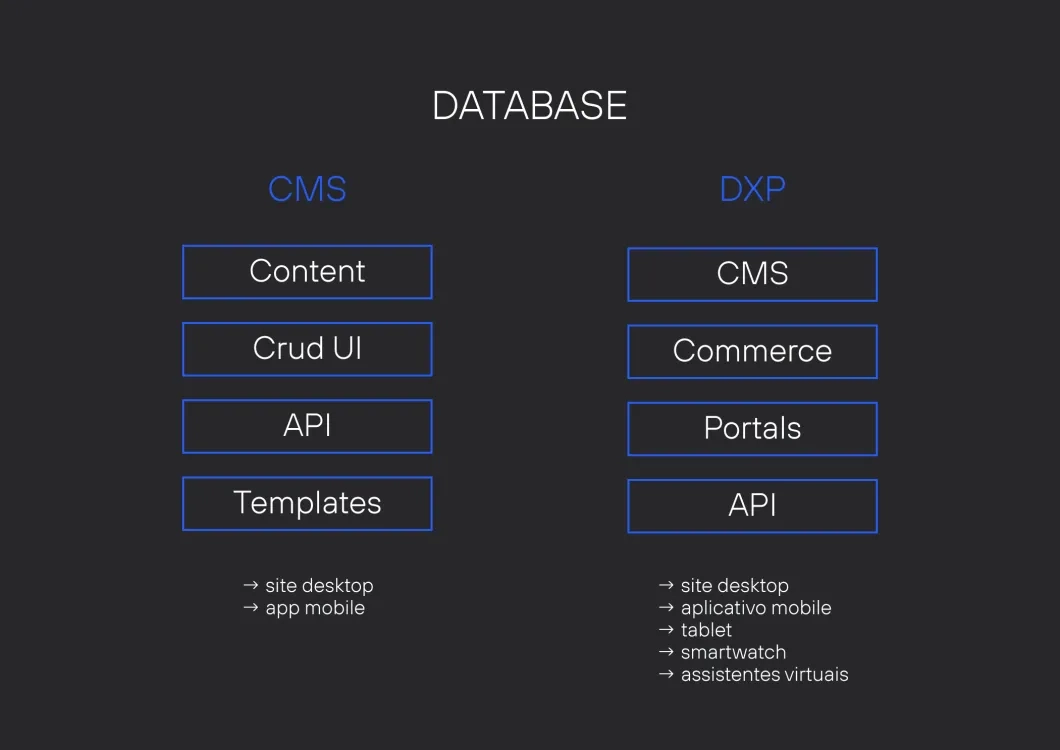DXP vs CMS in 2025: key differences, advantages, and how to choose
July 17, 2025
If you’ve made it here, chances are this sounds familiar: content needs to go live, marketing teams want autonomy, IT is stretched thin, and your website can’t keep up with the growing complexity of your digital operations. That’s when the inevitable question arises: DXP vs CMS: which solution meets your current needs?
This isn’t a rare dilemma, especially for companies scaling fast or restructuring their digital strategy. As personalization, integration, and scalability become critical, the limitations of traditional platforms start to show.
In this article, you’ll learn the key differences between a CMS and a DXP, and why Drupal offers a robust foundation to operate efficiently with both.
Talk to an expert about CMS and DXP
What is a CMS?
In practice, a CMS (Content Management System) is a platform that allows teams to create, manage, and publish digital content without needing to write code. You’ve likely used or heard of popular CMS platforms like WordPress, Wix, or Drupal.
CMSs shaped the modern web. Years ago, they replaced the tedious process of coding pages one by one, enabling organizations to launch and manage websites and portals more easily and systematically.
Since then, much has changed. Today’s CMS platforms offer intuitive dashboards, approval workflows, media libraries, SEO tools, form builders, plugins, and more. They’ve become essential for marketing, content, and design teams, empowering them to create, edit, and launch new pages and campaigns with agility, without relying on IT for every update.
As digital experiences expand across multiple channels and demand higher levels of personalization, CMSs have evolved. New architectures like headless and hybrid CMS emerged, capable of delivering content not only to websites but also to apps, smart devices, public displays, voice assistants, and beyond.
Here’s how they differ:
- Traditional CMS: the classic model where the front-end (user interface) and back-end (content management) are tightly coupled. It renders content directly as web pages;
- Headless CMS: decouples the content from the presentation layer, exposing it via APIs so it can be consumed by any front-end, whether it’s a website, mobile app, kiosk, or voice assistant;
- Hybrid CMS: combines the best of both worlds, offering API-driven flexibility along with visual tools for content creation and management.
Modern CMS platforms go far beyond basic publishing. They support no-code editing, multi-channel publishing, approval workflows, security integrations, and analytics connectivity to track performance and user behavior.
What is a DXP?
Over time, simply publishing content stopped being enough. Companies began navigating multiple channels, diverse audiences, and increasingly fragmented customer journeys. That’s where DXPs (Digital Experience Platforms) come in, a category of platforms designed to orchestrate the entire digital experience.
While a CMS focuses on what gets published, a DXP manages how, where, to whom, and with what level of personalization that content is delivered. It connects technologies, data, and real-time interactions to create seamless, personalized, and integrated experiences across every touchpoint.
A DXP is not just a CMS with extra plugins. It’s a strategic digital ecosystem, built to scale, customize, and unify customer interactions across channels. That’s why it often becomes the central hub for organizations that treat user experience as a core business strategy.
Also read: Digital Experience Platforms: How to Build Meaningful Customer Experiences
What makes up a DXP
A Digital Experience Platform (DXP) is a modular, interconnected system composed of multiple tools and integrations. Together, they power personalized, scalable, and seamless digital experiences. Key components typically include:
- CMS: acts as the core for content creation and organization;
- Asset and data management: includes DAMs, CDPs, and databases that centralize digital assets and user data
- AI-powered personalization: Machine Learning tools that tailor content and experiences in real time based on user behavior;
- Omnichannel orchestration: publishes content across multiple channels and devices in a unified and consistent way;
- Engagement tools: features like chatbots, intelligent search, and recommendation engines enhance user interaction;
- CRM, automation, and analytics integrations: connect marketing, behavioral, and relational data to optimize the customer journey;
- Contextual delivery: uses factors like location, language, device, and user history to deliver relevant and personalized content.
A practical example
Imagine a brand operating in five countries, targeting three distinct audiences, and managing multiple communication channels, a website, an e-commerce platform, a mobile app, email campaigns, and social media. In the context of DXP vs CMS, instead of using separate tools to manage each touchpoint, the company could adopt a DXP to orchestrate everything from a single, centralized environment.
This unified approach enables consistent digital experiences, where content is automatically adapted to each channel, language, and user profile, without redundant work or fragmented operations.
DXP vs CMS: what’s the real difference?
DXPs represent a shift in digital thinking. They’re built on the idea that experiences shouldn’t be static, that users should see different content, interfaces, and journeys, even when accessing the same domain.
In this sense, while a CMS solves editorial needs, a DXP tackles broader business challenges: acquisition, conversion, retention, satisfaction, and scalability.

Three core pillars that differentiate a DXP
Microservices architecture
Unlike many monolithic CMSs, modern DXPs are built on microservices, independent modules that communicate via APIs. This means each component (like authentication, search, personalization, or analytics) can evolve separately, offering faster development and reduced technical risk.
Composable by design
DXPs enable organizations to build their digital architecture on demand, integrating external tools in a plug-and-play fashion. Rather than being locked into a single suite, companies choose the best components for their needs and connect them in real time.
MACH principles: Microservices, API-first, Cloud-native, Headless
This modern framework is the backbone of many DXPs. It combines flexibility, scalability, and vendor independence, allowing seamless integration with platforms like Salesforce, HubSpot, Unomi, Google Analytics, or OpenAI, without being tied to a closed ecosystem.
DXP vs CMS: a side-by-side comparison
| Criteria | CMS | DXP |
|---|---|---|
| Primary focus | Content management | Digital experience management |
| Personalization | Limited (manual, static) | Advanced (dynamic, data-driven, AI-powered) |
| Integrations | Basic, plugin-based | Native and complex (CRM, CDP, automation, etc.) |
| Customer journey | Fragmented | Omnichannel and continuous |
| Global scalability | Basic multi-site | Multichannel, multilingual, multiregional |
| Data and analytics | Basic (via external tools) | Real-time, integrated across the ecosystem |
| Agility & time-to-market | Dependent on IT | High autonomy and automation |
| Governance & security | Modular | Centralized, with built-in compliance and auditing tools |
Which one should you choose?
The honest answer may surprise you: it depends on your company’s stage, and in many cases, the right answer is both.
Today, many CMS platforms are evolving into the core of a DXP. That’s because most DXPs still rely on a CMS as the foundation for content creation, layering in personalization, data, automation, and integrations on top. Instead of thinking in terms of replacement, consider it a natural evolution.
When a CMS is the right fit
If your organization needs a robust platform to securely manage and publish content with editorial control and scalability, a CMS does the job well. It's an ideal solution for corporate websites, blogs, intranets, and content-heavy projects with limited personalization requirements.
When a DXP becomes essential
As your digital operation becomes more complex with multiple channels, diverse audiences, and the demand for personalized, data-driven experiences, a CMS alone starts to fall short. That’s where a DXP becomes critical, acting as a strategic engine for unifying systems, personalizing journeys, and turning digital experience into a competitive advantage.
Signs it’s time to migrate to a DXP
Your company may be ready for a DXP if you:
- Need to integrate data from various sources (CRM, CDP, analytics, campaigns);
- Want to deliver personalized experiences by channel or persona;
- Manage multiple domains, languages, or customer segments;
- Face operational bottlenecks between marketing, IT, and customer service.
If these challenges sound familiar, you’re likely at the stage where a DXP is no longer optional. It’s strategic. This migration helps centralize your digital efforts and orchestrate every touchpoint in the customer journey.
Think Transition, Not Disruption
The future of web architecture is composable and integrated. APIs, microservices, and modular stacks make it possible to start small with a CMS and progressively scale toward a full DXP ecosystem.
If your initial platform already supports this flexibility (like Drupal does), then your transition will be smoother, less costly, and far more controlled at every stage.
DXP vs CMS: What to Expect in 2025
The digital platforms market is undergoing a major shift. The debate around DXP vs CMS is no longer just about content management; it has become a long-term strategic decision about how organizations orchestrate integrated digital experiences. Here are some of the key developments shaping this transition:
Rapid growth of DXPs
Digital Experience Platforms are expanding quickly, driven by three major forces: the demand for real-time personalization, the rise of composable architectures (flexible and modular), and the integration of generative AI into customer journeys. According to Gartner, the global DXP market is expected to reach $5.9 billion by 2028, with annual growth rates of 15–20%, fueled primarily by industries like retail, financial services, and healthcare.
The rise of composable DXPs
By 2026, Gartner predicts that 70% of enterprises will have adopted composable DXPs, highlighting the growing need for architectures that can adapt to increasingly complex digital ecosystems. In this model, the CMS continues to play a crucial role as the editorial and governance layer. At the same time, the DXP builds on top of it with data integration, automation, and advanced personalization.
Headless becoming the norm
Industry forecasts also point to the consolidation of headless CMS models. By 2025, more than 60% of new CMS implementations are expected to be headless, designed to integrate with DXPs seamlessly. While this shift delivers scalability and a stronger ROI, it also introduces challenges such as higher integration complexity and the need for more advanced technical expertise.
CMS platforms are not being replaced; they’re evolving to coexist with DXPs. The CMS ensures content governance and editorial consistency, while the DXP extends these capabilities with intelligence, omnichannel integration, and personalization at scale. Together, they create a strategic pathway for organizations competing in an increasingly fragmented and data-driven digital landscape.
Combining a CMS with a DXP often delivers higher ROI, global scalability, and more personalized customer journeys. At the same time, it requires careful planning, higher integration costs, and specialized teams. The most common approach in 2025 is gradual evolution: starting with a robust CMS and expanding step by step into a composable DXP architecture.
Why Drupal might be the right fit
Drupal stands out as one of the most flexible platforms on the market, making it capable of acting as a powerful CMS or the foundation of a composable DXP, depending on how your company’s digital needs evolve.
Its modular architecture allows organizations to start lean and scale gradually, adding features like AI-powered personalization, marketing automation, multi-site management, and integration with external systems as needed.
Why Drupal is an ideal foundation for a DXP
Advanced content modeling
Drupal’s taxonomy system and structured content framework enable granular control over how content is organized and delivered, which is critical for dynamic personalization.
API-first architecture
Since version 8, Drupal has followed a headless-ready, API-first approach, making it easy to deliver content across channels, including web, mobile, kiosks, and voice assistants.
Open and integrable ecosystem
Drupal connects seamlessly with tools like Salesforce, HubSpot, Unomi, Google Analytics, and OpenAI. This gives companies the freedom to build a tailored tech stack without being locked into a closed suite.
Global scalability
Drupal supports dozens or even hundreds of websites within a single infrastructure. It offers built-in multilingual capabilities, regional customization, and granular access control.
Real-time personalization
The platform adapts content dynamically based on user profile, location, behavior, and referral source, all in real time and with enterprise-level security.
If your goal is to combine content governance with seamless experience orchestration, Drupal offers the ideal balance of technical control and creative freedom.
Also read: What is Drupal? A complete guide to the CMS behind the world’s leading digital experiences
When to use Drupal as a CMS
Drupal is a solid choice for companies that need a robust, scalable, and secure CMS, even without leveraging the full capabilities of a DXP. It fits perfectly in projects where the primary goal is structured content publishing with editorial control and high availability. Here are some key use cases:
- Institutional websites and content portals: when the priority is to organize and present information, consistently and at scale;
- Projects requiring strict editorial governance: Drupal offers workflows, revisions, permissions, and detailed checkpoints to ensure content quality and compliance;
- Environments with multiple users and access roles: granular permission management is native to the platform;
- Security and stability requirements: used by governments and universities, Drupal is trusted for meeting strict security standards;
- Projects with growth in mind: even if starting as a traditional CMS, Drupal’s architecture supports a smooth evolution to headless models or full DXPs without rewriting from scratch.
In short, Drupal as a CMS fully meets content publishing demands while laying the foundation for a more integrated, personalized, and omnichannel digital future.
When to use Drupal as a DXP
If your project requires experience personalization, integration with external systems, and multichannel delivery, Drupal goes far beyond a CMS. It becomes the foundation of a composable digital experience platform, capable of centralizing data, automating user journeys, and personalizing interactions based on context and behavior.
Here are some ideal use cases:
Organizations with multiple channels and diverse audiences: when there’s a need to deliver tailored experiences across devices and user segments;
Projects focused on automation and personalization: Drupal can integrate with AI engines and CDPs like Apache Unomi to deliver real-time, dynamic content;
Composable architectures: Drupal connects natively to CRM, marketing automation, analytics, DAMs, email platforms, and more;
Global scalability requirements: supports multi-site deployments, multilingual content, and regional variations under centralized governance;
Omnichannel journeys: perfect for connecting content with apps, portals, gated areas, media campaigns, e-commerce platforms, and other key touchpoints.
Ultimately, when considering DXP vs CMS, Drupal offers a versatile path that allows your strategy to grow and shift as business needs evolve.
Why Dexa is a trusted partner in this space
Dexa operates at the intersection of technology, UX, and digital strategy, with deep specialization in Drupal-based projects, both as a CMS and as a composable DXP. We don’t just implement features; we deliver architectures of value, with a strong focus on scalability, personalization, and digital performance.
What sets us apart:
Drupal expertise: our team stays close to the ecosystem, actively participates in events like DrupalCon, and leads global projects with complex integrations;
Complex projects, clear delivery: we have experience in multilingual portals, multi-site infrastructures, and integrations with tools like Salesforce, CDPs, marketing automation, and AI engines;
Multidisciplinary approach: we bring together experts in design, UX, engineering, and digital strategy to craft complete solutions—from interface to backend, from content structure to user journey;
Governance as a core principle: we prioritize frameworks that offer autonomy for marketing, technical control for IT, and real-time data for business decisions.
In practice, our role is to help organizations simplify their digital presence, accelerate value delivery, and build experiences that truly align with what matters most: the user.
FAQ: CMS vs DXP
DXP: advanced data integration (CRM, CDP), AI-driven personalization, omnichannel orchestration, and global scalability.
- Need for integration with CRM, analytics, or campaign data;
- Managing multiple domains, regions, or languages;
- Growing demand for personalized experiences by audience or channel.
- Higher initial costs;
- Need for specialized technical teams;
- Organizational culture shift from content-first to experience-first thinking.
